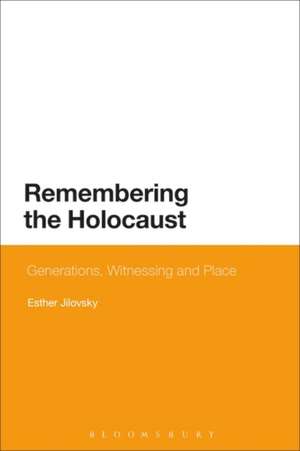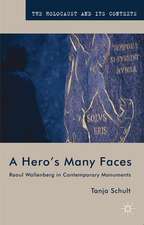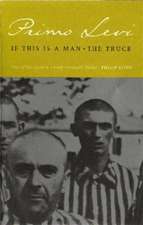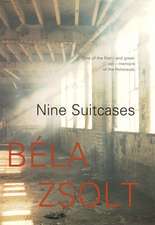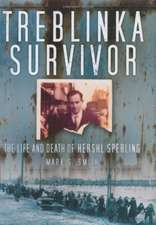Remembering the Holocaust: Generations, Witnessing and Place
Autor Dr Esther Jilovskyen Limba Engleză Paperback – 22 feb 2017
| Toate formatele și edițiile | Preț | Express |
|---|---|---|
| Paperback (1) | 257.03 lei 6-8 săpt. | |
| Bloomsbury Publishing – 22 feb 2017 | 257.03 lei 6-8 săpt. | |
| Hardback (1) | 773.65 lei 6-8 săpt. | |
| Bloomsbury Publishing – 26 aug 2015 | 773.65 lei 6-8 săpt. |
Preț: 257.03 lei
Preț vechi: 295.14 lei
-13% Nou
Puncte Express: 386
Preț estimativ în valută:
49.19€ • 51.04$ • 41.11£
49.19€ • 51.04$ • 41.11£
Carte tipărită la comandă
Livrare economică 15-29 martie
Preluare comenzi: 021 569.72.76
Specificații
ISBN-13: 9781350025134
ISBN-10: 1350025135
Pagini: 240
Dimensiuni: 156 x 234 x 18 mm
Greutate: 0.34 kg
Ediția:NIPPOD
Editura: Bloomsbury Publishing
Colecția Bloomsbury Academic
Locul publicării:London, United Kingdom
ISBN-10: 1350025135
Pagini: 240
Dimensiuni: 156 x 234 x 18 mm
Greutate: 0.34 kg
Ediția:NIPPOD
Editura: Bloomsbury Publishing
Colecția Bloomsbury Academic
Locul publicării:London, United Kingdom
Caracteristici
Includes a rare chapter dedicated to the third generation, the grandchildren of Holocaust survivors
Notă biografică
Esther Jilovsky is Honorary Fellow in German Studies at the University of Melbourne, Australia. She is the editor of In the Shadows of Memory: The Holocaust and the Third Generation (2016).
Cuprins
PrefaceIntroduction: Generations, Witnessing and PlaceChapter 1: Survivor Memoirs of Return: Encountering the Past in the PresentChapter 2: The Second Generation: Searching for the Past at Sites of MemoryChapter 3: The Third Generation: The Role of Place in Imagining the PastChapter 4: The Paradox of Place and Bearing Witness: Manipulated Topographies, Pilgrimage and Holocaust TourismConclusion: If Place is not a Witness, what is?NotesBibliographyIndex
Recenzii
Esther Jilovsky's monograph focuses on literary texts by survivors of the Holocaust, and by children and grandchildren of survivors. She intertwines literary analysis with the study of generations, memory and place, the discourses on place providing the anchor for the discussions about memory and its relationship to generations of the Holocaust. Jilovsky's book is wide-ranging in its theoretical scope, which she handles in a refreshingly clear and engaging style. I warmly recommend this important study not only to specialists in the field, but also to those looking for new readings for their students in courses on Holocaust literature, representation, memorialization and education.
Remembering the Holocaust: Generations, Witnessing and Place explores how encounters with the historical sites of the Holocaust are constitutive for descendants of Holocaust survivors, functioning as a touchstone for memory and identity and fueling a wave of generational writing about the Holocaust's abiding legacy. These public spaces of historical suffering (most prominently the locus of the former concentration and death camp Auschwitz) not only have become sites of pilgrimage for a globalized Holocaust memory, they also function in the contemporary literary imagination as proxies for the experience of the Holocaust. Jilovsky insightfully argues that recent generational writing on touristic encounters with Holocaust sites marks a shift in the focus of memory from the testimony of the survivors to the geographical place of their experiences. By virtue of their spatial contiguity, such sites are expected to grant particularly immediate and authentic access to the events of the Holocaust. As Jilovsky shows, however, these iconic places are unable to offer the fervently desired connection to the past, for they remain inexorably anchored in the present.
Remembering the Holocaust pulls together an impressive body of current Holocaust research to draw our attention to the role of place in Holocaust narratives. Investigating the gap between place and narration, the book boldly illuminates the incongruity in our approach to former sites of terror that are expected to convey Holocaust memories but simultaneously acknowledge the very impossibility of doing so. Jilovsky carefully elucidates texts by the first, second, and third generation to highlight the complexity of memory places and critically shed light on various kinds of travel to such sites. Her work thus underscores the importance of physical sites in literary representations while precisely examining the entanglements between place and memory.
Remembering the Holocaust: Generations, Witnessing and Place explores how encounters with the historical sites of the Holocaust are constitutive for descendants of Holocaust survivors, functioning as a touchstone for memory and identity and fueling a wave of generational writing about the Holocaust's abiding legacy. These public spaces of historical suffering (most prominently the locus of the former concentration and death camp Auschwitz) not only have become sites of pilgrimage for a globalized Holocaust memory, they also function in the contemporary literary imagination as proxies for the experience of the Holocaust. Jilovsky insightfully argues that recent generational writing on touristic encounters with Holocaust sites marks a shift in the focus of memory from the testimony of the survivors to the geographical place of their experiences. By virtue of their spatial contiguity, such sites are expected to grant particularly immediate and authentic access to the events of the Holocaust. As Jilovsky shows, however, these iconic places are unable to offer the fervently desired connection to the past, for they remain inexorably anchored in the present.
Remembering the Holocaust pulls together an impressive body of current Holocaust research to draw our attention to the role of place in Holocaust narratives. Investigating the gap between place and narration, the book boldly illuminates the incongruity in our approach to former sites of terror that are expected to convey Holocaust memories but simultaneously acknowledge the very impossibility of doing so. Jilovsky carefully elucidates texts by the first, second, and third generation to highlight the complexity of memory places and critically shed light on various kinds of travel to such sites. Her work thus underscores the importance of physical sites in literary representations while precisely examining the entanglements between place and memory.
